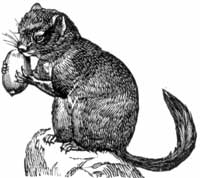
Dormouse
Background Information
This content from Wikipedia has been selected by SOS Children for suitability in schools around the world. Visit the SOS Children website at http://www.soschildren.org/
| Dormice Temporal range: Early Eocene - Recent |
|
|---|---|
 |
|
| African Dormouse, Graphiurus sp. | |
| Scientific classification | |
| Kingdom: | Animalia |
| Phylum: | Chordata |
| Class: | Mammalia |
| Order: | Rodentia |
| Suborder: | Sciuromorpha |
| Family: | Gliridae Muirhead in Brewster, 1819 |
| Subfamilies and Genera | |
|
Graphiurinae
Leithiinae
Glirinae
|
|
Dormice are rodents of the family Gliridae. (This family is also variously called Myoxidae or Muscardinidae by different taxonomists). Dormice are mostly found in Europe, although some live in Africa and Asia. They are particularly known for their long periods of hibernation.
Characteristics
Dormice are small for rodents, with a body length of between 6 and 19 centimetres (2.5 - 7.5 inches), and weighing between 15 and 200 grams. They are generally mouse-like in appearance, but with furred, rather than scaly, tails. They are largely but not exclusively arboreal animals, and are agile and well adapted to climbing. Most species are nocturnal. Dormice have an excellent sense of hearing, and signal each other with a range of different vocalisations.
Dormice are omnivorous, typically feeding on fruits, berries, flowers, nuts and insects. Dormice are unique among rodents in that they lack a cecum, a part of the gut used in other species to ferment vegetable matter. Their dental formula is similar to that of squirrels, although they often lack premolars:
| Dentition |
|---|
| 1.0.0-1.3 |
| 1.0.0-1.3 |
Dormice breed once or twice a year, producing litters with an average of four young after a gestation period of 21-32 days. They can live for as long as five years. The young are born hairless, and helpless, and their eyes do not open until about eighteen days after birth. They typically become sexually mature after the end of their first hibernation. Dormice live in small family groups, with home ranges that vary widely between species, and depending on the availability of food.
Hibernation
One of the most notable characteristics of those dormice that live in temperate zones is hibernation. Dormice can hibernate six months out of the year, or even longer if the weather remains sufficiently cool, sometimes waking for brief periods to eat food they had previously stored nearby. During the summer, they accumulate fat in their bodies, to nourish them through the hibernation period.
It is from this trait that they got their name, which comes from Anglo-Norman dormeus, which means "sleepy (one)"; the word was later altered by folk etymology to resemble the word "mouse". The sleepy behaviour of the Dormouse character in Lewis Carroll's Alice's Adventures in Wonderland also attests to this trait.
Relationship with Man
The edible species was considered a delicacy in ancient Rome, either as a savoury appetizer or as a dessert (dipped in honey and poppy seeds). The Romans had a special kind of enclosure known as glirarium used to rear dormice for the table.
Evolution
Currently, the earliest fossil evidence of dormouse species comes from Europe in the early Eocene . They appear in Africa in the upper Miocene and only relatively recently in Asia. Many types of extinct dormouse species have been identified. During the Pleistocene, giant dormice the size of large rats, such as Leithia, lived on the islands of Malta and Sicily.
Classification
The family consists of 34 living species, in three subfamilies and (arguably) 10 genera:
Family: Gliridae
- Subfamily Graphiurinae
- Genus Graphiurus ( African dormouse)
- Species Graphiurus angolensis, (Angolan African dormouse)
- Species Graphiurus christyi (Christy's Dormouse)
- Species Graphiurus crassicaudatus (Jentink's Dormouse)
- Species Graphiurus johnstoni (Johnston's African dormouse)
- Species Graphiurus kelleni (Kellen's Dormouse)
- Species Graphiurus lorraineus (Lorrain Dormouse)
- Species Graphiurus microtis (Small-eared Dormouse)
- Species Graphiurus monardi (Monard's Dormouse)
- Species Graphiurus murinus (Woodland Dormouse)
- Species Graphiurus nagtglasii (Nagtglas's African dormouse)
- Species Graphiurus ocularis (Spectacled Dormouse)
- Species Graphiurus platyops (Rock Dormouse)
- Species Graphiurus rupicola (Stone Dormouse)
- Species Graphiurus surdus (Silent Dormouse)
- Genus Graphiurus ( African dormouse)
- Subfamily Leithiinae
- Genus Chaetocauda
- Species Chaetocauda sichuanensis (Chinese Dormouse)
- Genus Dryomys
- Species Dryomys laniger (Woolly Dormouse)
- Species Dryomys niethammeri (Niethammer's forest dormouse)
- Species Dryomys nitedula (Forest Dormouse)
- Genus Eliomys (Garden dormice)
- Species Eliomys melanurus (Asian Garden Dormouse)
- Species Eliomys munbyanus (Maghreb garden dormouse)
- Species Eliomys quercinus (Garden Dormouse)
- Genus Hypnomys† (Balearic dormouse - extinct)
- Species Hypnomys morphaeus†
- Species Hypnomys mahonensis†
- Genus Muscardinus
- Species Muscardinus avellanarius (Hazel Dormouse)
- Genus Myomimus (Mouse-tailed dormouse)
- Species Myomimus personatus (Masked Mouse-tailed Dormouse)
- Species Myomimus roachi (Roach's Mouse-tailed Dormouse)
- Species Myomimus setzeri (Setzer's Mouse-tailed Dormouse)
- Genus Selevinia
- Species Selevinia betpakdalaensis (Desert Dormouse)
- Genus Chaetocauda
- Subfamily Glirinae
- Genus Glirulus
- Species Glirulus japonicus (Japanese Dormouse)
- Genus Glis
- Species Glis glis (Edible Dormouse)
- Genus Glirulus

